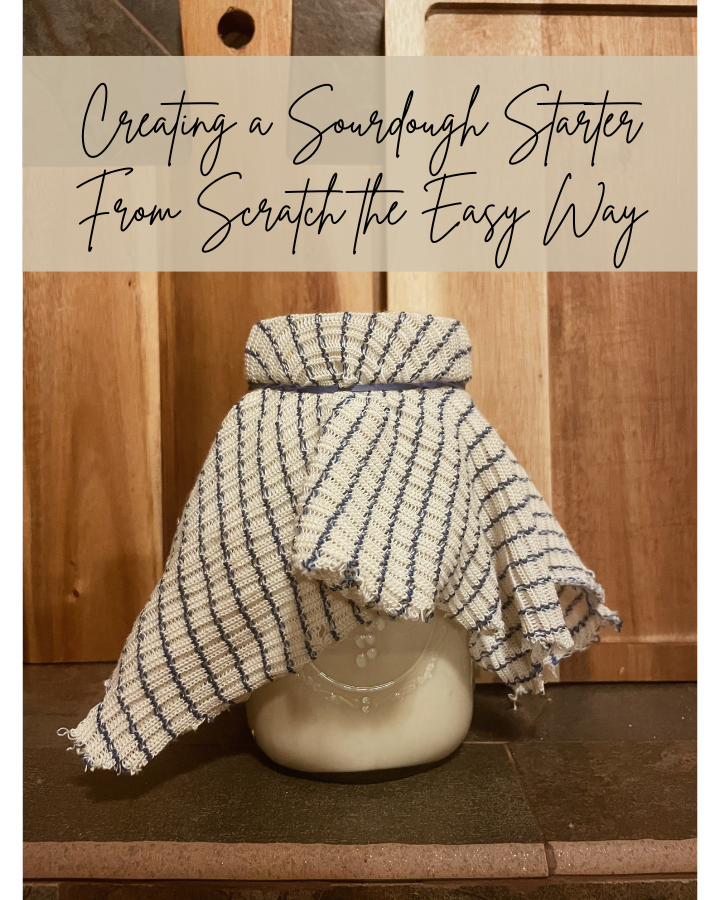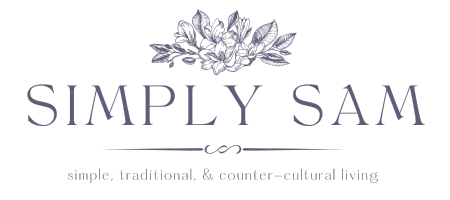Many people don’t want to dive into the world of sourdough because they think it’s too complicated and high-maintenance. I’m here to show you how to create a sourdough starter from scratch the easy way.

With more time and less confidence in the food systems, many women began their journey with sourdough during the pandemic. I followed suit last year in 2021 as I started to live a more simple, self-sufficient, and natural lifestyle. The idea of baking with sourdough intrigued me. I love to cook and bake, so it only seemed natural that I would start baking with sourdough. I also plan to have a homestead in the future, and it seemed like all homesteading women had starters. Not to mention the health benefits of sourdough that you can read more about in this post.
my sourdough journey
Around that same time in 2021, I started to focus more on my health and wellness. A majority of that focus was on the things I was putting on and into my body. I got rid of all the toxic products I used, stopped cooking with PUFAs, and started cooking with mostly organic foods. Once I learned the ingredients that are in conventional bread I knew I needed to start baking my own sourdough.
I’d be lying if I said I wasn’t overwhelmed at the beginning of my sourdough journey. It seems like there is so much to learn, so many things to buy, and so much time to spend before you’re even able to bake something. While that is true to an extent, I don’t think it has to be overwhelming. I’m the type of person who likes to do everything perfectly and by the book. I think it might be the scientist in me. But once I started baking more, I realized that cooking and baking are art forms, not sciences. There are so many factors that play into it that can’t be accounted for in a recipe. I started out thinking sourdough was a science, but once I realized it was an art, it became so much easier and more fun.
what is a sourdough starter
A sourdough starter is a mixture of flour and water that creates a live culture of microbes through wild fermentation. That simply means that you rely on naturally occurring yeast and bacteria to ferment the food. In this case, the flour and water mixture grabs yeast and bacteria from the air, the jar, the spoon, the flour, and the water. This was how bread was made before isolated yeast was available in stores. Once the starter is established and full of life, it can be used to make all sorts of baked goods.
The starter is composed of just three ingredients: flour, water, and air. Those three things then take over to create a mixture of yeast and bacteria. Yeast from the surrounding environment enters the jar and ferments the carbs in the flour into alcohol and carbon dioxide. Then, the bacteria in the starter metabolize the alcohols into acetaldehyde and then into acetic acid. Yeasts make the bubbles, and bacteria make the flavor.
Now that you know what a sourdough is and how it works, let’s learn how to make one.
supplies needed to create a sourdough starter from scratch
There’s only a few things you need to get a sourdough starter started from scratch. What’s really great is that you probably have most, if not all of these things at home already.
- Glass jar
- A lid that isn’t airtight / a tea towel or cheese cloth
- Wooden spoon or spatula
- Organic unbleached all-purpose flour
- Lukewarm filtered water
the process of creating a sourdough starter from scratch
Day one
Put 25g of flour and 25g of water into your glass jar and mix well. Make sure there are no clumps of flour left. Cover it with the lid or cloth and let sit for 24 hours.
day two – day five
Pour 25g of your starter into a new, clean glass jar. Add at least 25g of water and mix well. Then add at least 25g of flour into the jar and mix well. Cover it with the lid or cloth and let sit for 24 hours.
day six – day seven (Or until the starter is established)
Pour 25g of your starter into a new, clean glass jar. Add at least 25g of water and mix well, and then at least 25g of flour and mix well. Cover it with the lid or cloth and let sit for 12 hours and repeat.
common questions when creating a sourdough starter from scratch
how do i make maintaining a sourdough starter simpler?
My main piece of advice is to not overcomplicate it. As long as you feed it on a regular basis it will be fine. Feed it how ever much you want as long as you add more grams of flour and water than there are grams of starter. I said to add 25g of everything in my instructions, but you can add any amount. You could add more than 25g or your could add less than 25g.
You really don’t even need to measure or weigh out the ingredients once you get a hang of it and know what it should feel/look like. Once you’re done mixing the starter, water, and flour, it should look like thick pancake batter. After a while you’ll know what consistency works best for you and your starter in the environment of your home, and then you can just get it there without measuring or weighing.
Why do i have to discard part of my starter?
Because microbes grow exponentially, your starter will grow exponentially as well. This means that you will eventually have more starter than you can handle if you don’t discard some of it every time you feed it. Discard into the trash or compost, or give to the farm animals during the first week. Once the starter is established and ready to be used, you can save the discard in the fridge to use in recipes specifically designed for sourdough discard. The fresh starter you use in recipes that call for bubbly, active starter also count as “discard” for that day.
how do i know when my starter is ready to be used?
Your starter will be bubbly, smell like strong sourdough bread, and double in size after feeding when it is active and ready to be used in recipes. You can also check by placing a spoonful of starter into a cup of water. If it floats, it’s ready. If it sinks, it’s not ready. I only accounted for seven days in the process section, but it may take your starter longer than that depending on its environment.
what type of flour should i use in my starter?
You can use any type of starchy flour. Starches are the carbs in the flour, which is what the microbes use for food. This is essentially any type of flour- all-purpose, einkorn, bread flour, cassava, whole wheat, etc. I have heard that using almond flour (or a similar gluten-free alternative) is a little difficult because there is not much starch.
how do i take care of my starter once it’s established?
Once your starter is established, you have a few options. Your first option is to leave it out on your counter and feed it every one to two days. This is a good option if you are going to be using your starter a lot during the week.
Your other option is to feed it and store it in your fridge with an airtight lid. It can stay good in your fridge for up to two weeks. This option is good if you only need your starter for a recipe once a week or so. Then you don’t have to waste a bunch of flour by feeding it everyday. Just take it out of the fridge a couple days before you’re going to bake with it and feed it like normal. I plan to write a post about using your sourdough starter soon, so I will go into more detail about this in that post.
can a sourdough starter go bad?
Sourdough starters are very resilient. It takes a lot for you to ruin them. A lot of people dump them out and start all over because they think it went bad. Usually, all you need to do is take a small bit of the starter that still looks good and feed it. It may take a little while for the starter to become healthy and established again, but it shouldn’t be ruined. The only way it will go bad is if it gets taken over by bad bacteria, which would only happen if you neglected it for months on end because the good bacteria is strong enough to win over the bad bacteria.
what is the dark liquid layer on top of my starter?
This dark liquid is simply a layer of alcohol. It’s completely harmless and doesn’t mean that your starter has gone bad. It just means it’s hungry. The alcohol is a byproduct of the fermentation process, and when the microbes don’t have enough fuel to eat through, this alcohol builds up and becomes visible. You can stir the hooch into the starter, or dump it off. The only thing you need to do to prevent this from happening is to feed your starter more often.
If you made it to the end of this post, thank you for reading and keep your eyes peeled for more sourdough related content in the future!
